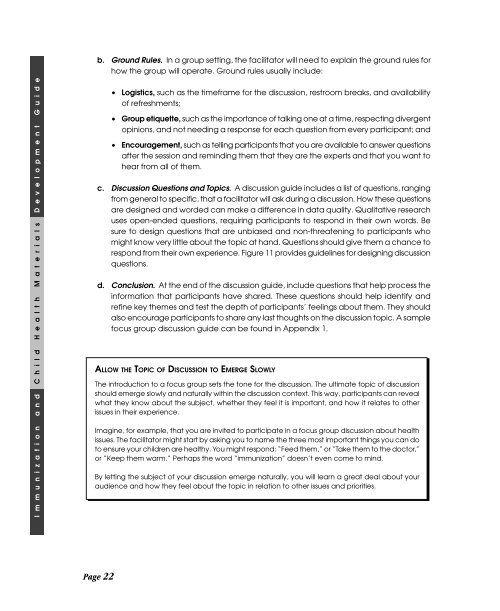Immunization and child health materials development guide pdf
Immunization and child health materials development guide pdf
Immunization and child health materials development guide pdf
Create successful ePaper yourself
Turn your PDF publications into a flip-book with our unique Google optimized e-Paper software.
. Ground Rules. In a group setting, the facilitator will need to explain the ground rules for<br />
how the group will operate. Ground rules usually include:<br />
• Logistics, such as the timeframe for the discussion, restroom breaks, <strong>and</strong> availability<br />
of refreshments;<br />
• Group etiquette, such as the importance of talking one at a time, respecting divergent<br />
opinions, <strong>and</strong> not needing a response for each question from every participant; <strong>and</strong><br />
• Encouragement, such as telling participants that you are available to answer questions<br />
after the session <strong>and</strong> reminding them that they are the experts <strong>and</strong> that you want to<br />
hear from all of them.<br />
c. Discussion Questions <strong>and</strong> Topics. A discussion <strong>guide</strong> includes a list of questions, ranging<br />
from general to specific, that a facilitator will ask during a discussion. How these questions<br />
are designed <strong>and</strong> worded can make a difference in data quality. Qualitative research<br />
uses open-ended questions, requiring participants to respond in their own words. Be<br />
sure to design questions that are unbiased <strong>and</strong> non-threatening to participants who<br />
might know very little about the topic at h<strong>and</strong>. Questions should give them a chance to<br />
respond from their own experience. Figure 11 provides <strong>guide</strong>lines for designing discussion<br />
questions.<br />
d. Conclusion. At the end of the discussion <strong>guide</strong>, include questions that help process the<br />
information that participants have shared. These questions should help identify <strong>and</strong><br />
refine key themes <strong>and</strong> test the depth of participants’ feelings about them. They should<br />
also encourage participants to share any last thoughts on the discussion topic. A sample<br />
focus group discussion <strong>guide</strong> can be found in Appendix 1.<br />
ALLOW THE TOPIC OF DISCUSSION TO EMERGE SLOWLY<br />
The introduction to a focus group sets the tone for the discussion. The ultimate topic of discussion<br />
should emerge slowly <strong>and</strong> naturally within the discussion context. This way, participants can reveal<br />
what they know about the subject, whether they feel it is important, <strong>and</strong> how it relates to other<br />
issues in their experience.<br />
Imagine, for example, that you are invited to participate in a focus group discussion about <strong>health</strong><br />
issues. The facilitator might start by asking you to name the three most important things you can do<br />
to ensure your <strong>child</strong>ren are <strong>health</strong>y. You might respond: “Feed them,” or “Take them to the doctor,”<br />
or “Keep them warm.” Perhaps the word “immunization” doesn’t even come to mind.<br />
By letting the subject of your discussion emerge naturally, you will learn a great deal about your<br />
audience <strong>and</strong> how they feel about the topic in relation to other issues <strong>and</strong> priorities.<br />
Page 22

















